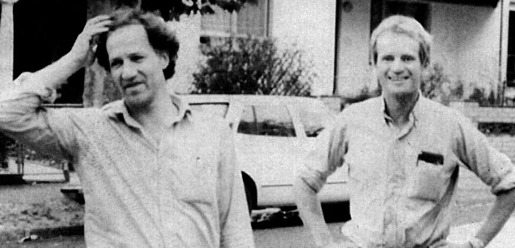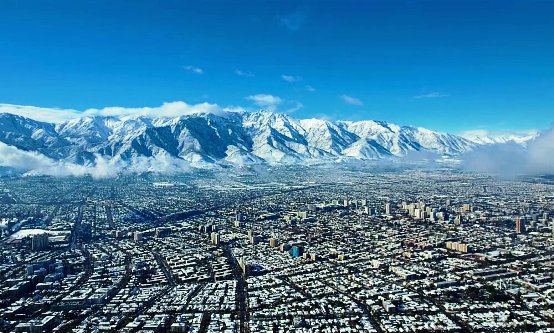 Werner Herzog presents a portrait of his friend, the journalist and travel writer Bruce Chatwin; while Patricio Guzmán examines the mountain range dividing Chile’s coast from its interior, drawing conclusions both literal and symbolic.
Werner Herzog presents a portrait of his friend, the journalist and travel writer Bruce Chatwin; while Patricio Guzmán examines the mountain range dividing Chile’s coast from its interior, drawing conclusions both literal and symbolic.
Bruce Chatwin was an English travel writer, journalist, novelist, and sort of an amateur anthropologist as well. His meteoric writing career started at the Times of London in the early ‘70s, where he honed his skills describing interesting and out of the way travel destinations. His books centered on the idea that human beings are essentially nomads, an idea he explored in six books of fiction and non-fiction, with his most famous and popular work “The Songlines,” published in 1987. He died from AIDS two years later at the age of 48.
German director Werner Herzog has made a film about Chatwin called Nomad: In the Footsteps of Bruce Chatwin. Now, if you want a straight biography of Chatwin, this isn’t it. Herzog has always practiced his own personal form of documentary filmmaking. The term “documentary” implies an attempt to present an objective view of a topic—Herzog’s non-fiction works are more like “essay films” because, although they always center on a particular topic of some interest, the information he presents is filtered through his own unique point of view on that topic, often ranging widely around it as well. In Nomad he travels to several places that Chatwin wrote about, discussing Chatwin’s ideas, insights, and discoveries, while also describing his own thoughts on the same things, and how he and Chatwin’s thought coincides and differs. The one element of this that I didn’t realize going in, and which makes the film special, is that Chatwin and Herzog were friends. They met in 1983 and were close until the time of Chatwin’s death.
Herzog succeeds in impressing the audience with Chatwin’s absolutely extraordinary character and talent. The notion of human beings as essentially nomadic wanderers resonates strongly with Herzog’s own views. His image in popular culture may tempt us to not take him seriously as a thinker, but I find him consistently meaningful and challenging, and Nomad is his most personal non-fiction film yet, because of the emotional bond he had with his friend.
When we get to “The Songlines,” the film does a good job of describing that book’s very complex subject: the mystical practices of aboriginal Australians, who mapped the outback’s vast and forbidding landscapes using songs as markers. This ties in to a profound experience of time, a construction of reality of which the colonizers had little or no conception. Nomad presents highlights from Chatwin’s investigations that tantalize and inspire us to learn more.
 Another documentary in a different vein but with emotional similarities is The Cordillera of Dreams, by the eminent Chilean filmmaker Patricio Guzmán. Guzmán’s life as an artist has centered on the trauma of the 1973 coup that established a military dictatorship in Chile, documented in his classic 1979 film The Battle of Chile. Since the dictatorship ended in 1990, he has sought to connect ideas about the natural world and spirituality with his political insights.
Another documentary in a different vein but with emotional similarities is The Cordillera of Dreams, by the eminent Chilean filmmaker Patricio Guzmán. Guzmán’s life as an artist has centered on the trauma of the 1973 coup that established a military dictatorship in Chile, documented in his classic 1979 film The Battle of Chile. Since the dictatorship ended in 1990, he has sought to connect ideas about the natural world and spirituality with his political insights.
The cordillera is the mountain range separating the much more populous coastal areas of Chile from the rugged interior. Guzmán carefully presents us with details on this magnificent natural feature, gradually making the leap into extended metaphor, in which the cordillera mirrors the power of oppressors throughout history, including the conquest of the natives by the Spanish, down to today’s sharp difference between the upper classes and the majority of the Chilean people. A deeper symbolism is invoked in the idea of the coastal cities as a way of life that needs to integrate with the pristine natural forces of our world that lie on the other side of the mountains.
The Cordillera of Dreams, like all of Guzmán’s films, is a satisfying mix of spiritual wisdom and incisive social commentary. Guzmán is more overtly political than Herzog, but this film shares with Nomad a fascination with truths, however strange they might be, about people and their societies.

The classic Harlem Renaissance novel by Ella Larsen about the American delusion of race is beautifully adapted by Rebecca Hall. Passing is a remarkable...

In his first English language film, Jacques Audiard gives us an interesting and off-beat take on the outlaw Western genre. When I first saw...

A delightful and humorous celebration of sexual fetishes, as practiced by solitary people trying to get beyond social repression to create pleasure; a rare...